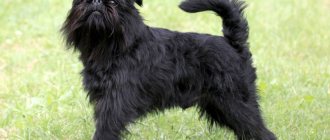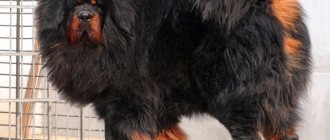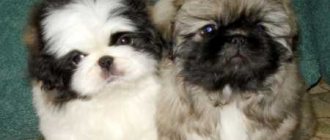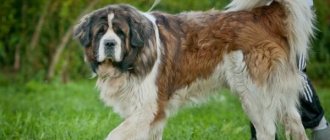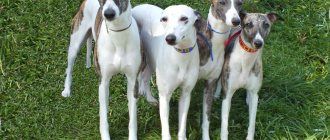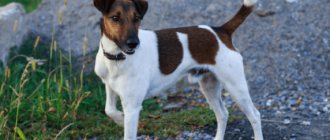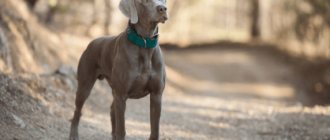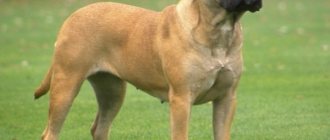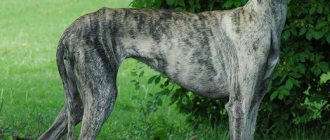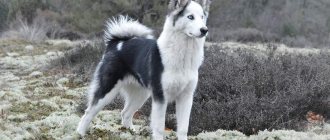Main characteristics
| Breed parameters | |
| Country of origin: | Great Britain |
| Weight of the breed: | males: 2.5-3.5 kg, females: 2.5-3.5 kg |
| Height at withers: | male: 25-31 cm, females: 25-31 cm |
| Temperament: | moderate |
| Wool: | short |
| Role in human life: | companion |
They are ideal companions, loyal and devoted friends. They get along well with children and get along with other pets, however, they require attention, love and care.
Origin story
The basis for the creation of the English Toy Terrier was the larger representative of the terrier - the Manchester. These animals quickly gained popularity and were the favorites of many noblemen of the Victorian era. Despite their very modest size, they performed well in hunting foxes and other burrowing animals, and also participated in rat fights. The dog was locked in a small pen along with a certain number of huge rats and it was supposed to quickly kill everyone.
Somewhat later, this entertainment was banned and they became simply rat catchers, which was very helpful during the plague epidemic. Over time, the first kennel club was organized in Britain, which specialized in organizing dog shows.
Previously, the breed was called the Miniature Black and Tan Terrier; they appeared in their current title only in the 60s. For many years, English Toy Terriers and Manchester Terriers were confused and even considered the same breed. And this is not surprising, because the former descended from the latter, and over time, the blood of the British began to be added to Manchester.
Prices
When an English Toy Terrier is chosen for home keeping, the price can fluctuate significantly. Its average range is between 20,000-60,000 rubles.
There are also areas with lower costs. Its main distribution by region is:
| Place | Price |
| Vladimir | 25 000 |
| Krasnodar | 20 000 |
| Crimea | 23 000 |
| Moscow | 40 000 |
| Novosibirsk | 30 000 |
| Saint Petersburg | 60 000 |
| Saratov | 20 000 |
| Yaroslavl | 30 000 |
If you want to have a British Terrier, you should take into account the main characteristics of the breed. The animals do not require complex care and are very affectionate and active. But owners should pay attention to the vulnerability of such a dog and show it to the veterinarian more often. In addition, you must strictly follow the vaccination schedule.
a brief description of
Today, English Toy Terrier dogs are on the verge of extinction. If the population issue is not resolved in the near future, humanity may be left without a wonderful companion.
These animals have a miniature build and a rather serious character. They are excellent companions who are always close to a person and follow on his heels. Toys become very attached to their owner and cannot imagine life without him. They are wary of strangers and loudly announce their approach. Dogs are very energetic, active, love care and require attention. Dogs practically do not shed and do not require complex care. This pet will be an ideal pet for the whole family.
How to train correctly?
Due to the fact that English toy terriers can be quite stubborn and headstrong, you need to start raising and training your pet as early as possible - literally from the day you acquire it.
Dogs of this breed are smart and quick-witted and, as a rule, remember new commands well. But they do not always do them, but only when there are no other, more interesting things to do.
That is why it is so important to achieve impeccable obedience from the toy, because otherwise you may not be able to cope with your pet in a critical situation when, for example, he runs out onto the highway chasing a cat.
IMPORTANT!
When raising and training an English Toy Terrier, you cannot yell at him or punish him unfairly. This will only make the dog even more stubborn. In addition, this can greatly frighten the puppy and even ruin his psyche.
Breed standard
The English Toy Terrier is a smooth-haired dog characterized by its short stature, graceful build, elongated face, thin paws, large ears and beady eyes. The clarity of his movements indicates his breed. Compact, with well-developed muscles and strong bones. Height at withers up to 31 cm, weight approximately 3 kg.
- The head is elongated, in the form of a modified wedge. The skull is narrow, flat, and there is a small groove in the forehead area. The cheekbones are flat, there is a slight transition from the nose to the forehead, the length of the muzzle is equal to the length of the head. The nose mirror is voluminous, clearly visible, and the color is black.
- The ears are large, narrow, pointed at the ends, set high and close to the head. The direction is up and forward. Previously they were docked, but today it is prohibited.
- The eyes resemble black beads, have a characteristic shine, are set close to each other, the outer corner is raised up. The eyelids are dense, fit well to the skull, and have a black edging. The expression of the eyes is intelligent and alert. Large, excessively bulging eyes or, conversely, too small eyes are unacceptable.
- The neck is slightly arched, graceful, gradually widening towards the withers, thin at the base of the head.
- The withers are well defined and muscular.
- The back is straight, muscular, and short. The groin area is wide.
- The croup is rounded and somewhat sloping.
- The chest is narrow, the ribs are flattened, the stomach is retracted.
- The tail is of medium length, mobile, set low, wide at the base and tapering towards the end.
- The limbs are straight, the front elbow joints are tightly pressed to the body, directed strictly back. The hind limbs are muscular, the knee joints are well defined. The paw pads are small, with neat toes.
- The claws are pronounced and black. Movement is free, with good rear push.
- The coat is very short, shiny, and somewhat harsh to the touch. Acceptable color is black with bright tan.
English cocker spaniel
The English Cocker is larger than its American cousin and was bred to hunt woodcock.
This is a noble lord in a dog's body, whose history dates back to the mid-19th century . The distinctive features of the breed are long ears and a red color.
English Mastiff
The ancient breed of mastiffs appeared at the beginning of the 15th century and were used to protect the owner and his property, and was also used for military purposes and in dog fighting.
English Springer Spaniel
A gundog breed, it was used for hunting and delivering prey such as waterfowl. Excellent at looking for smuggling and migrant workers , a good-natured daredevil with an inexhaustible supply of vital energy.
English Foxhound
The fox (parataya) hound breed appeared in the 16th century and was used for hunting foxes. It has become widespread in the USA, Europe and Canada.
The Foxhound is the most famous breed of English hounds.
Bedlington Terrier
Known for its resemblance to a lamb, the terrier was created to hunt and kill rodents in mines. Also a champion in greyhound racing, agility and other sports, it is an excellent swimmer and can also be used in hunting ducks and other waterfowl.
Character and temperament
The English Toy, unlike many terriers, has a balanced character and a stable psyche. Nervous tremors are extremely rare in them, which is essentially a disadvantage of the breed.
Toys love to be the center of attention, they are a little selfish and believe that the whole world should revolve around them. They often have a “Napoleon complex”. The dog is confident in its superiority and tries to convince everyone at home of it.
These pets enjoy spending time with their family. They love children and play well with them. Very young children may be a little wary, as they are careless in their movements and can unknowingly cause pain. Therefore, it is very important to explain to your children how to behave with living beings, especially if they are small.
Although toys are excellent companions, they should not be classified as useless decorative dogs. The hunting instinct is in their blood. Sometimes echoes of the past make themselves felt and the dog cannot resist a “scandal” with larger dogs.
A brave and courageous dog needs early socialization. If you do not pay due attention to this, you can end up with an unpredictable and uncontrollable pet that will bark for days on end and attack everything that moves.
An English Toy can be very jealous; you need to fight this character trait from childhood. It is best if the puppy grows up in a family that has other pets.
Otherwise, these are loving animals, ready to give joy and love to people.
Cavalier King Charles Spaniel
Cavalier King Charles Spaniel
This breed, along with its brother, the King Charles Spaniel, was used for hunting back in the 18th century, and now it has become a companion dog with a soft, easy-going character.
The long-eared baby is graceful, has a cute appearance - he is simply created to create comfort in the home.
Clumber Spaniel
A hunting dog with French roots, it was created as a gun dog. These affectionate and friendly dogs are strong and resilient.
The breed is named after the Clumber Park estate in Nottinghamshire.
Lakeland Terrier
Rarely found outside England, where it was bred in the mountains of the Lake District and is used for hunting burrowing animals. This is an incredibly nimble terrier with a piercing gaze and many talents.
Manchester Terrier
At the beginning of the 19th century , it was used as a guide dog, and also destroyed rats and mice that threatened human health. Originally from Manchester, the agile terrier has a strong hunting instinct.
Education and training
Animals are endowed with good mental abilities, however, they can be excessively stubborn. It is better to start training after six months; before six months it will be useless. To achieve a good result, the owner will have to be patient. If you cannot cope with your pet, then it is best to enlist the help of an experienced dog handler.
A specialist will help you correctly create a training schedule, correctly distribute lessons and sequence of commands. In the process of training, in no case should you offend the dog or raise a hand against him. Training must be built on trust.
Nutrition
A puppy's diet is different from that of an adult dog. The number of feedings also differs. An adult should receive food twice a day, a puppy - 3-4, depending on age.
The animal's daily diet must contain lean meat, meat and bone components, cereals, vegetables and fruits, as well as additional vitamins and minerals. Puppies can be given cottage cheese, milk, and fermented milk products.
What not to give:
- Fatty pork, lamb.
- Bakery products.
- Sweets and chocolate.
- Tubular bones.
- I'm eating from the table.
Super-premium food for small breeds can be a substitute for natural food.
How to choose the right puppy?
Since the breed is quite rare, buying such a pet is not as easy as we would like. However, if you set yourself a goal, you can find quite decent nurseries. You will have to choose a foreign friend based on a photo and rely only on the information provided. However, this is not a Staffordshire Terrier, whose psyche must be checked, so there is not much chance of getting an unbalanced animal.
To avoid getting a “pig in a poke,” it is best to find a nursery in your country and personally visit the breeder. Preliminary acquaintance with the future family member will allow you to make the right choice.
At the time of sale, a purebred puppy must have a full package of documents: a veterinary passport with vaccination marks, a document of origin, a pedigree.

